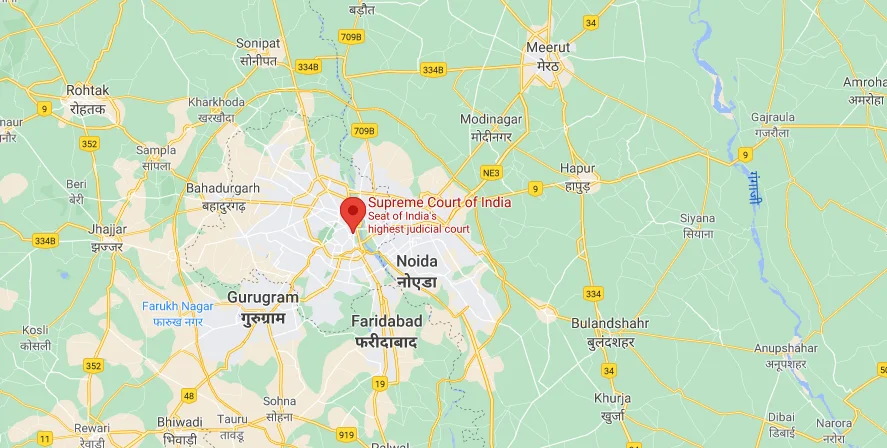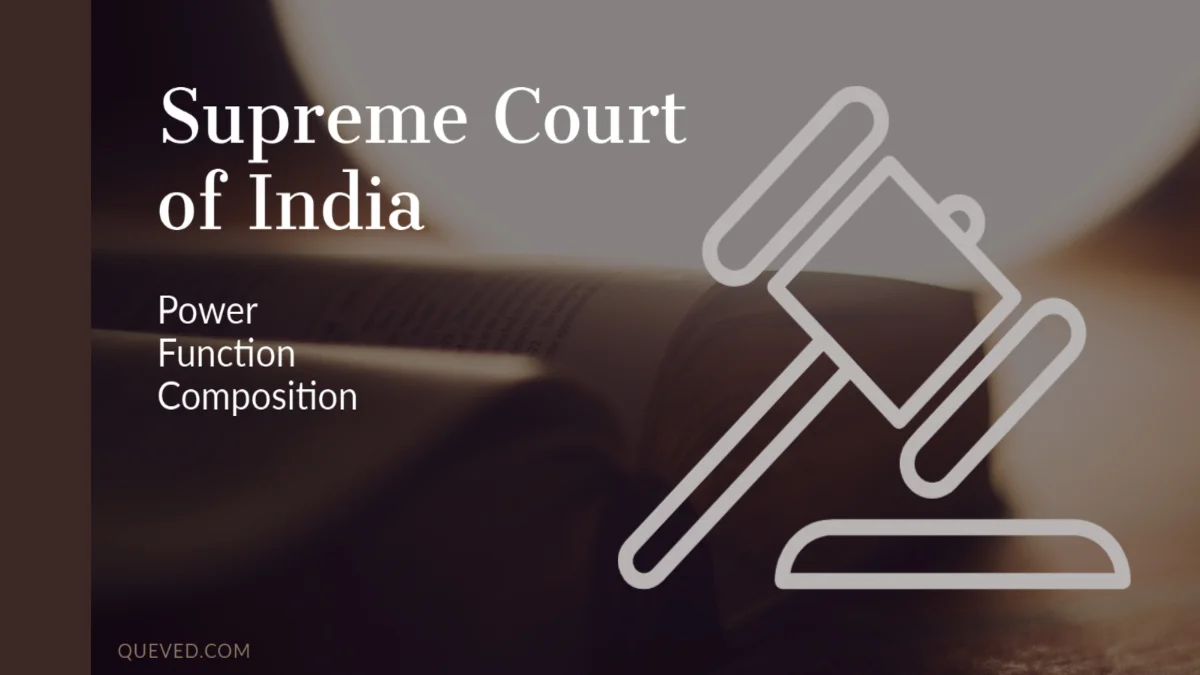The Supreme Court of India is the country’s highest and most powerful court. The Supreme Court was created by the Constitution as a (1) Federal Court, (2) Court of Appeal, (3) Constitutional Guardian, and (4) Court of Record. All other courts within the Indian territory are bound by the law declared by it in the execution of any of its constitutional jurisdictions.
On January 28, 1950, the Supreme Court of India was established. The Federal Court of India, which was created by the Government of India Act of 1935, was superseded by it.
The Organization, Independence, Jurisdiction, Powers, Procedures, etc. of the Supreme Court are addressed in Articles 124 to 147 of Part V. The Parliament shall also be empowered to regulate it.
The President appoints all judges of the Supreme Court. The President will consult the Chief Justice of India before making the appointment. The Governor of the State is responsible in the matter of appointment of a Judge other than the Chief Justice.
In the federal system of India, the Supreme Court acts as the federal court. According to the constitution, parliament can determine the number of judges of the Supreme Court by law. Initially, the Supreme Court consisted of one Chief Justice and seven other judges. In April 1986, the number of judges was increased to 26. In other words, the Supreme Court consists of one Chief Justice and 25 Assistant Judges.
History of Supreme Court of India:
The Indian High Court Act was passed in 1861. The Act established High Courts in a number of states and three presidency cities, Calcutta, Madras, and Bombay. These courts used to be the region’s highest courts. In all situations, the newly formed High Courts continue to serve as the apex court. The Government of India Act of 1935 established the Federal Court of India. Disputes between provinces and federal states were resolved, and challenges against the High Court’s decision were granted.

Eligibility/Qualifications to become a judge of the Supreme court [Article124 (3)]
There are certain qualifications required to be a judge of the Supreme Court, such as:
- Must be Indian citizenship.
- 5 years experience of working as a Judge in any High Court or multiple High Courts.
- Experience of working as an Advocate in one or more High Courts for ten years.
- The President may appoint a prudent lawyer as a judge of the Supreme Court.
Recruitment procedure
The Chief Justice of the Supreme Court is appointed by the President of India (Article 124). The President consults with the Chief Justice before appointing other judges. However, it cannot be said that he is compelled to act on the advice of the Chief Justice. There is a practice of appointing a Muslim judge in the Supreme Court.
The concept of seniority is generally followed in the appointment of the Chief Justice. However, in some cases, the concept of aging has been violated. In 1973, Roy was appointed Chief Justice. At the time, the law minister said that the president had the opportunity to exercise his discretion in appointing the chief justice of the Supreme Court.
On the advice of the Prime Minister and the Law Minister, the President appoints justices of the Supreme Court, in fact. The report of the Law Commission commented that communal and regional considerations have influenced the appointment of judges.
Salary and allowances of a Judge of Supreme Court:
The Chief Justice of the Supreme Court receives a monthly salary of Rs 1 lakh. Other judges receive a monthly salary of Rs 90,000. Along with the salary, they enjoy free accommodation, pension and other benefits.
The neutrality of the judge of the supreme court:
Some measures have been taken in the constitution to maintain the neutrality of the judges.
- When appointing judges of the Supreme Court, the President also consults with the Chief Justice of the Supreme Court before acting on the advice of the Union Cabinet.
- The Supreme Court mentions special procedures for the removal of judges. The president can remove the justices of the Supreme Court, according to a resolution passed by parliament.
- The allowances and other benefits of judges are determined by the Act of Parliament. But after the appointment of a judge, allowances and other benefits cannot be changed against his interests. However, if the country declares a state of financial emergency, the president can reduce the salaries of the judges of the Supreme Court.
- Judges of the Supreme Court cannot practice their duty in any court of India after retirement.
- According to the Constitution, the conduct of the judges of the Supreme Court cannot be discussed in Parliament. Only a motion to remove a judge can be discussed in Parliament.
Tenure
Supreme Court judges can hold office till the age of 65. However, before that any judge can resign voluntarily.
Advocates for the Supreme Court:
Advocates fall into three categories when it comes to practicing law before the Supreme Court. They are as follows:
Senior Advocates: Senior Advocates are advocates who have been appointed as such by the Supreme Court of India or any High Court. The Court may designate any Advocate as Senior Advocate with his assent if the Court believes that he is deserving of such distinction due to his skill, standing at the Bar, or unique knowledge or expertise in law. In the Supreme Court, a Senior Advocate cannot appear without an Advocate-on-Record. Also in any other court or tribunal in India, a Senior Advocate cannot attend without a junior.
Advocates-on-Record: Only these advocates are entitled to file any matter or document before the Supreme Court.
Other Advocates: Advocates whose names are on the list of any State Bar Council kept under the Advocates Act, 1961, are known as other advocates. They can appear and argue any matter in the Supreme Court on behalf of a party, but they are not entitled to file any documents or matters with the Court.
The removal procedure of a Judge of the Supreme court:
Special procedures have to be followed to remove the judges of the Supreme Court. According to the constitution, the president can remove a judge on charges of misconduct or incompetence. However, he can remove any judge of the Supreme Court on the basis of a resolution passed in Parliament. If a motion to remove a judge is approved by a majority of the total members and a portion of the members present with voting in both houses of parliament, the President has the authority to remove that judge.
According to the constitution, judges cannot be engaged in the legal profession in any court of India after retirement. However, many times retired judges have been appointed to the posts of Vice President, Minister, Governor, Ambassador, or Vice-Chancellor of the University. According to many critics, this is against the impartiality of judges. That is why this practice should be abolished.
According to the Constitution, the Supreme Court will sit wherever the Chief Justice of the Supreme Court of India decides. The Supreme Court hearing was held in public, and the verdict of the case was announced in public.
Powers and Functions of the Supreme Court:
The Supreme Court of India has four types of powers, namely:
Original Jurisdiction: The Supreme Court settles disputes between the states of India. The Supreme Court is in charge of resolving disputes between the states and the center. Furthermore, if there is a dispute over the interpretation of the constitution, the Supreme Court’s decision is final. For this reason, the Supreme Court is called the analyst and guardian of the constitution.
Appellate Jurisdiction: The Supreme Court uses this power to hear appeals from various Indian High Courts for civil, criminal, and constitutional actions.
Advisory Jurisdiction: If the President requests the Supreme Court’s advice or opinion on any legal issue, the Supreme Court will provide it. If the President seeks the Supreme Court’s opinion on a constitutional interpretation, the Supreme Court may inform the President. The President, on the other hand, has the option of accepting or rejecting the Supreme Court’s interpretation.
Order Jurisdiction: If a citizen’s fundamental rights are violated, he or she can seek remedies from the Supreme Court. By issuing orders, instructions, or permits, the Supreme Court can create provisions to protect it.
Review Jurisdiction: According to Article 137 of the Constitution, the Supreme Court has the authority to review any laws passed by the legislature.
Other powers of the Supreme Court of India:
- It appoints its officers and servants in conjunction with the UPSC and establishes its service conditions with the President’s approval.
- With the President’s consent, it can enact regulations governing the court’s practice and procedure.
- It has the authority to select arbitrators to resolve cases and disputes involving excess expenditures spent by the State Government in carrying out Union government directives.
- It investigates presidential and vice-presidential election issues.
- Not only that, but it has the authority to recommend to the President for dismissal of the Chairman and members of the UPSC.
| Related to Read | Related to Read |
| Age Limit for Various Constitutional Post | Fundamental Duties of COI |
| Borrowed Features of Indian Constitution | 12 Schedules of Indian Constitution |
- File Name: Supreme Court of India GK PDF Notes
- File Type: PDF
- File Size: 167 KB
Supreme Court of India: A comprehensive note for aspirants who made their decision to become an IAS officer in India. For that, a piece of detailed knowledge regarding Indian polity is necessary. I hope this post will make you benefit. This note is also available in PDF format to download.
